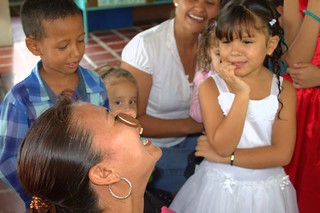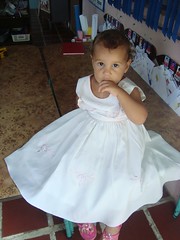 |
| We also celebrated Luz Maria's birthday on May 5. |
 |
| The gift of motherhood. |
Of course, that Sunday we remembered all mothers in the prayer of the church. Furthermore, instead of the straightforward Ascension narrative in Acts 1:1-11, I read the more symbolic account in Revelation 12:1-6. It is clear in John’s vision that the “Child caught up to God and His throne” is Jesus, and the dragon is “that serpent of old, called the Devil and Satan, who deceives the whole world”. But, who is the “woman clothed with the sun, with the moon under her feet, and on her head, a garland of twelve stars”? She is not sim ply Mary; the twelve stars indicate that, in the first verses, she represents the Old Testament people of God, with the twelve sons of Jacob as their patriarchs. In the Magnificat (Luke 1:46-55), Mary not only names herself the Lord’s maidservant, but says that with the conception of Jesus, God has remembered His servant, Israel, “as He spoke to our fathers, to Abraham and his seed, forever.”
 |
| Celebration Mother's Day. |
But the woman remains on earth, where she is pursued by the dragon and his angels for a short time (until Christ returns in glory). Here she symbolizes the New Testament people of God, with the twelve apostles as the patriarchs.
So in the Revelation account, we have the complete cycle of the earthly ministry of Jesus, from the Incarnation to the AscLension, followed by the age of the church and its mission to proclaim the Gospel to all nations. God the Son leaves to one side the fullness of His divine power, but honors motherhood and our human nature by being born of a woman, then exalts humanity further by ascending not only as true God, but as true man.
 |
| Trinity of Friedensau. |
Conviction rather than convenience
 |
| My grandparents on their wedding day. |
 |
| My grandparent' s grave. |
In 1974, I attended the centennial anniversary celebration of Trinity Lutheran Church of Friedensau, Nebraska. Recently I was invited to the 150th anniversary on Sunday, June 9, 2024, by the current pastor, José Flores. I thanked Pastor Flores for the invitation, but said I would not be able to attend due the difficulties of travel to and from Venezuela.
What does this small congregation in rural Nebraska mean to me and my family? Henry F. Schabacker, my great-grandfather, served the church as pastor from the late 1890s to the late 1920s, the longest tenure of any pastor to date. He and his wife, Frederika, lived in the first parsonage, and raised 10 children at Friedensau.
One of their daughters, Theodora Amanda, married a young man from Texas who was the teacher in the parochial school and the church organist, despite being paralyzed on one side of his body by polio. His name was David Julius Ernst. My grandparents also raised 10 children at Friedensau and their earthly remains are buried side by side in the church cemetery. Alfred H. Ernst, my father’s older brother, was one of the featured speakers at the centennial. At the time, he was the pastor of Trinity Lutheran Church, Lincoln, Nebraska. I do not remember his speech word for word, but according to a local newspaper clipping, “Rev. Ernst praised the church for the record it had made during the past century as it had produced 12 pastors, 27 parish teachers and one parish worker. He said the church had strengthened the faith so that it became a conviction rather than a convenience.”
 |
| Spanish Bible from LHF. |
In anticipation of their high school graduation in July, Eduar Garrido and his classmates have completed a project to distribute first aid supplies to educational institutions in our area. On May 23, they visited our preschool for this purpose. Eduar is a communicant member of our mission congregation and a past recipient of scholarships from LeadaChild, one of our sponsoring organizations. The other students are Cindy Escalona, Yandry Gómez, Tatiana Niño, Franyelis Martínez, Reinaldo Ramírez and Luisana Yañez.












